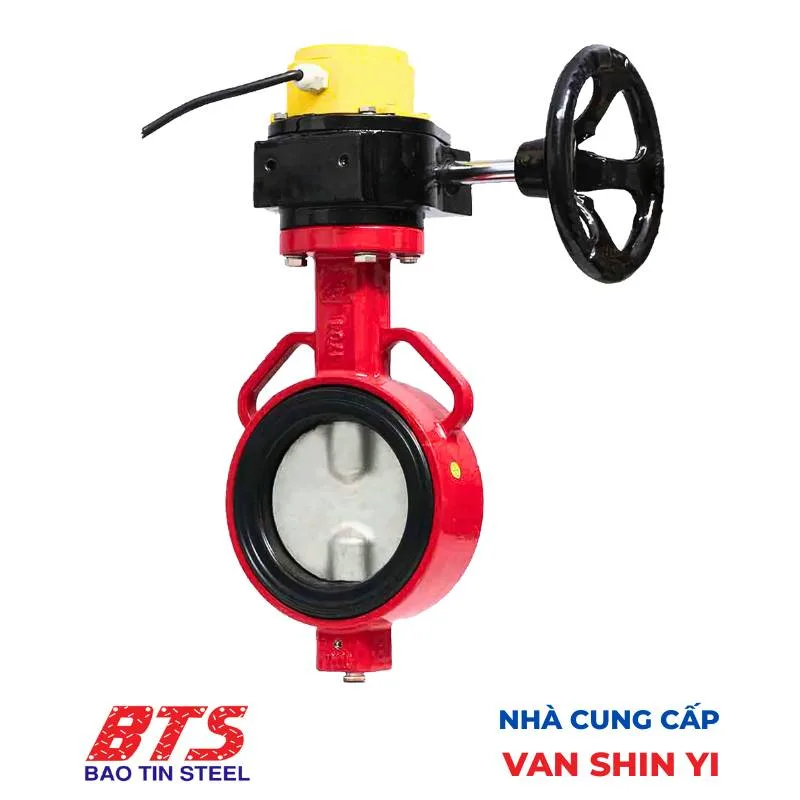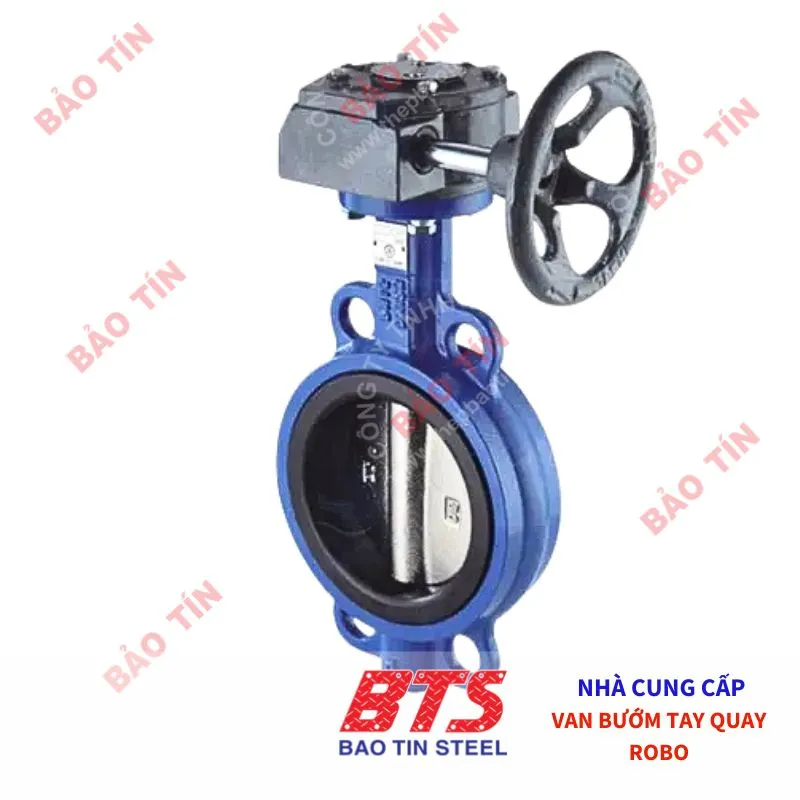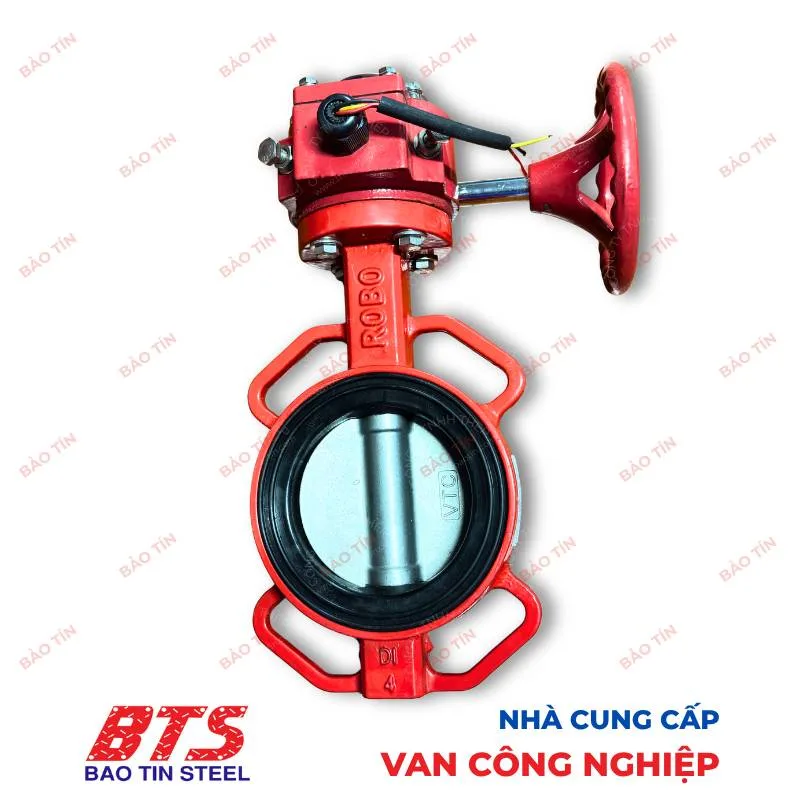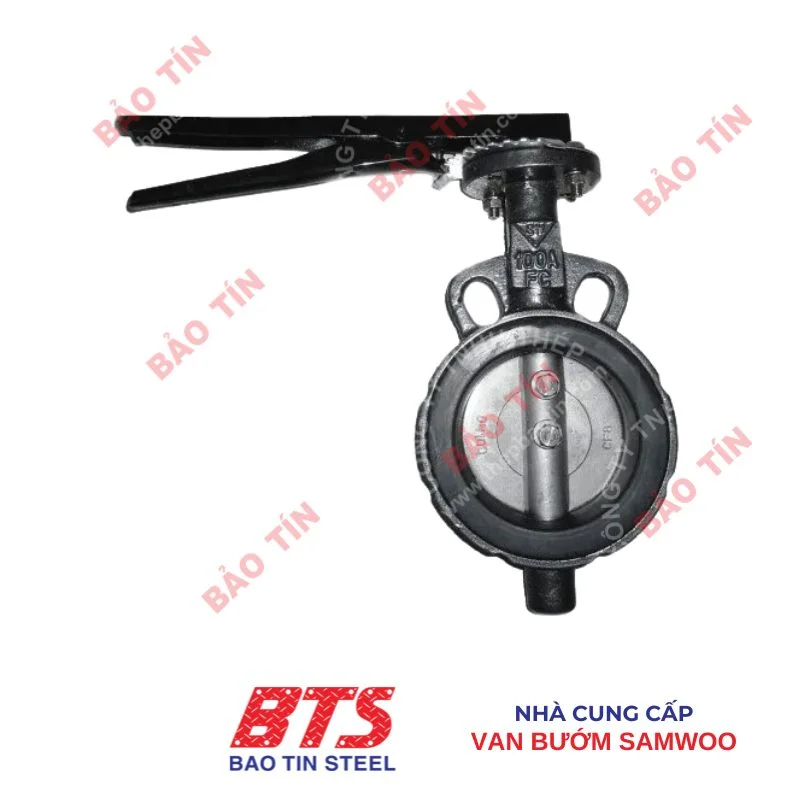Besides ball valves, gate valves, air release valves, flanged safety valves, etc., flanged butterfly valves are also a very commonly used type of valve. However, for new pipefitters just starting out, not everyone fully understands them. If you want to know what a flanged butterfly valve is and how many types there are, check out the article from Bao Tin Steel.
What is a Flanged Butterfly Valve?
Flanged Butterfly Valve is a type of valve made from materials such as cast iron, steel, plastic, or pressure-resistant stainless steel. The valve body is cast in one piece with two flanged ends, which makes it easy to connect to piping systems. This type of valve can be operated manually using a lever or handwheel, or it can be controlled by electric or pneumatic actuators.

In addition to the names mentioned above, this valve also goes by different names. Each place or person may have their own way of naming the valve. However, as long as the process of purchasing and communication is simple and effective, it works fine. Some of the common names we often encounter are:
- Flanged Butterfly Valve
- Butterfly Valve with Flange Connection
- Flanged Butterfly Valve Installation
- Flanged Type Butterfly Valve
- Double Flanged Butterfly Valve
Technical Specifications of Flanged Butterfly Valves
Below are the common technical specifications for flanged butterfly valves available in the market today:
- Size: DN50 – DN900
- Material: Cast iron, Stainless steel, Plastic
- Pressure Rating: PN10, PN16, PN25
- Working Temperature: 0 ~ 200°C
- Connection Type: Flanged
- Flange Standard: JIS, BS, DIN
- Origin: South Korea, China, Malaysia, Europe, Taiwan, Thailand, Japan.
Structure of a Flanged Butterfly Valve:
Similar to other types of valves, the flanged butterfly valve also consists of the following components:

- Valve Body:
The body is typically made of cast iron, stainless steel, or plastic. Special materials allow this valve to operate efficiently under pressure conditions ranging from 10k to 20k. - Valve Disc:
It is usually made of cast iron, steel, or stainless steel. The valve disc comes into direct contact with the fluid, so it’s important to know the system where the valve will be used in order to choose the appropriate butterfly valve with the right disc material. - Valve Shaft:
Usually made of stainless steel or high-strength steel, the shaft connects the valve disc to the actuator, helping in the opening and closing process of the valve. - Sealing Gasket:
The gasket helps seal the space between the valve body and the disc, minimizing leakage and noise. The gasket is typically made of materials like EPDM rubber, Viton rubber, or PTFE (Teflon). - Actuating Mechanism:
This component provides the force that acts on the valve shaft to open or close the valve. It can be a handwheel, lever, electric actuator, or pneumatic actuator.
>> You can also take a look at flanged ball valves to see the differences in the structure between these two types of valves.
Operating Principle of the Flanged Butterfly Valve
The operation of this butterfly valve is similar to other industrial valves, mainly relying on the rotational ability of the valve shaft. Specifically:
When the valve shaft is not actuated, the valve disc will fit tightly against the valve body. In other words, it is in a fully closed state, and the fluid cannot pass through.
Conversely, when the valve shaft is actuated (through a handwheel, lever, electric actuator, or pneumatic actuator), it will pull the valve disc along. The disc will rotate by 90 degrees or less, creating an opening for the fluid to pass through.
To close the valve, simply stop applying force to the shaft, and the valve will return to the closed state. The rubber gasket will help seal the valve body and the valve disc, blocking the flow of the fluid. Specifically, you can reverse the handwheel, switch off the electric switch, or turn off the pneumatic switch to close the valve.
As you can see, you have full control when operating the flanged butterfly valve. Depending on the specific needs, you can control the opening/closing of the valve or adjust the flow rate of the fluid.
Classification of Flanged Butterfly Valves
Flanged butterfly valves are very diverse in terms of material and operating methods. These are the factors that help classify this type of valve. Specifically:
Classification by Manufacturing Material
Flanged Cast Iron Butterfly Valve:
The cast iron used here is usually ductile. It has good load-bearing capacity, impact resistance, and heat resistance. Typically, flanged cast iron butterfly valves are coated with an epoxy layer to prevent rust. The cost of flanged cast iron valves is quite reasonable, which makes them widely used.
Flanged Stainless Steel Butterfly Valve:
The stainless steel used is primarily 304 stainless steel and 316 stainless steel. With a shiny appearance, excellent hardness, and rust resistance, flanged stainless steel butterfly valves are trusted in both large and small systems. However, due to its many outstanding features, this type of valve has a higher price compared to valves made from other materials.
Flanged Plastic Butterfly Valve:
As the name suggests, the primary material used here is plastic (PVC, uPVC, etc.). It can operate under PN16 pressure and at temperatures up to 95°C. The valve is quite durable, lightweight, easy to move and install. Plastic flanged butterfly valves are also resistant to corrosion, making them suitable for fuel systems. Because it’s made of plastic, this valve type is cheaper. However, its lifespan is generally shorter than valves made from other materials.
The material of the flange directly affects the piping system it connects to. Only materials that are compatible for connection will allow the valve to function properly and ensure safety. Additionally, the material also influences the price of the valve. You can read more about steel and stainless steel flange prices to gain more interesting knowledge.
Classification by Operating Method
Flanged Butterfly Valve with Handwheel:

This valve operates via a handwheel (steering wheel). When the handwheel is turned clockwise, the valve opens, and when turned counterclockwise, the valve closes. The flanged butterfly valve with handwheel operates manually. This feature allows technicians to easily monitor and quickly address any issues that arise.
Flanged Butterfly Valve with Lever:

This valve is also manually operated. Simply hold the lever and move it to the left or right by a sufficient angle to open/close the valve. Operating the valve is very easy and quick. Additionally, the cost of the flanged butterfly valve with lever is quite reasonable compared to many other types of flanged valves.
Flanged Butterfly Valve with Electric Actuator:

This valve is equipped with an actuator. It receives electrical energy and converts it into mechanical energy to operate the valve. The voltage used can be 24V, 110V, 220V, 380V, etc. The valve opens and closes very quickly. It can work simultaneously with many other devices. Additionally, this valve can be controlled remotely, meaning it can operate from any location it is installed.
Flanged Butterfly Valve with Pneumatic Actuator:

The primary energy used to operate this type of butterfly valve is compressed air. The valve body is equipped with a pneumatic actuator that converts compressed air into mechanical energy to control the opening and closing of the valve. We simply need to supply an appropriate amount of compressed air, and the valve will operate. Similar to electric actuators, this valve can be installed in various locations. However, its installation cost is relatively high because additional equipment is required, such as air compressors, air pipes, and pressure gauges. Therefore, this type of flanged butterfly valve is typically used in large systems that require high capacity.
Common Types of Flanged Butterfly Valves
As we can see, this type of valve is widely used in our country. In addition to South Korea and China, we also have flanged butterfly valves from Japan, Taiwan, Malaysia, and more. Each type of valve has its unique advantages. Therefore, you need to clearly understand which type you need and the technical specifications to choose the appropriate valve.
Above are the details about flanged butterfly valves and their variety. Feel free to contact Bao Tin Steel if you need assistance and a quotation for this type of flanged valve! – 0932 059 176.


 Tiếng Việt
Tiếng Việt ភាសាខ្មែរ
ភាសាខ្មែរ


